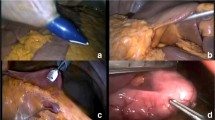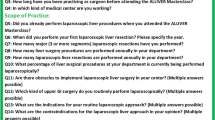Abstract
Background
Nowadays, the laparoscopic approach represents the gold standard for a wide range of various basic and advanced procedures. To reduce the learning curve in advanced laparoscopic surgery, the search for new teaching tools is of utmost importance. Our experiences with a new teaching tool to train advanced laparoscopic procedures are reported.
Methods
Hands-on training courses in colon, hernia, bariatric and vascular surgery using Thiel human cadavers (THCs) were organised by the Swiss Association of Laparoscopic and Thoracoscopic Surgery (SALTS). The courses were held by consultant surgeons expert in the field of minimal invasive surgery (MIS). At the end of each course, data was collected using a standardised, anonymous questionnaire using a Likert scale (1 = strongly disagree; 2 = disagree; 3 = neither agree nor disagree; 4 = agree; 5 = strongly agree). Data are presented as mean ± standard deviation (SD), percentages (%) or total number (n), if indicated.
Results
From January 2005 to May 2006, six courses (colon = 2; hernia = 2; bariatric = 1; vascular = 1) were organized with a total of 33 participants (31 consultant surgeons; two senior residents). The authenticity of tissue colour, tissue consistency and operative tactility, respectively, were stated for the courses as follows: colon (mean: 4.4/4.2/4.2), hernia (mean: 4.3/4.2/4.0), bariatric (mean: 4.5/4.8/4.3) and vascular (mean: 2.8/2.8/2.6) courses. A high mean overall satisfaction with the courses (colon: 4.0; hernia: 4.2; bariatric: 5.0 and vascular surgery: 4.1) was also observed. All participants of the colon, bariatric, hernia and vascular courses will recommend the courses to other surgeons.
Conclusion
Training on THCs might be an excellent additional model to teach advanced bariatric, hernia and colon surgery. However, an important issue that remains to be defined is which training model (THC, anesthetized animals, virtual computer training, etc.) is the most appropriate for the curriculum of the skill or procedure that is being trained.

Similar content being viewed by others
Abbreviations
- EAES:
-
European Association of Endoscopic Surgeons
- LS:
-
Likert scale
- MIS:
-
Minimal invasive surgery
- SAGES:
-
Society of American Gastrointestinal and Endoscopic Surgeons
- SALTS:
-
Swiss Association of Laparoscopic and Thoracoscopic Surgery
- SETC:
-
SwissEndos Training Centre
- SD:
-
Standard deviation
- SSS:
-
Swiss Society of Surgeons
- TAPP:
-
Transabdominal preperitoneal approach
- TEP:
-
Totally extraperitoneal approach
- THC:
-
Thiel human cadaver
References
Mühe C (1986) Cholecystektomie durch das Laparoskop. Langenbecks Arch Klein Chir 369:804
European Association of Endoscopic Surgeons (1994) Training and assessment of competence. Surg Endosc 8:721–722
Society of American Gastrointestinal Endoscopic Surgeons. (1991) Granting of privileges for laparoscopic general surgery. Am J Surg 161:324–325
Miko I, Furka I, Gamal EM, Metzger P, Sapy P (1997) Details of teaching, learning and training in laparoscopic surgery. Acta Chir Hung 36:230–232
Kirwan WO, Kaar TK, Waldron R (1991) Starting laparoscopic cholecystectomy-the pig as a training model. Ir J Med Sci 160:243–246
Villegas L, Schneider BE, Callery MP, Jones DB (2003) Laparoscopic skills training. Surg Endosc 17:1879–1888
Ali MR, Mowery B, Kaplan B, DeMaria J (2002) Training the novice in laparoscopy-More challenge is better. Surg Endosc 16:1732–1736
Thiel W (1992) The preservation of the whole corps with natural colour. Ann Anat 174:185–195
Groscurth P, Eggli P, Kapfhammer J, Rager G, Hornung JP, Fasel JDH (2001) Gross Anatomy in the Surgical Curriculum in Switzerland: Improved Cadaver Preservation, Anatomical Models, and Course Develompent. New Anat 265:254–256
Räder S, Hahnloser D, Clavien PA (2006) Is training of minimal invasive surgeons in Switzerland adequate? Swiss Knife (special edition) 2006:27. (Abstract)
Steinke W, Allemann F (2006) Future professional education in laparoscopic surgery as seen by the chief surgeons in Switzerland – A representative survey. Swiss Knife (special edition): 16. (Abstract)
Scott DJ, Bergen PC, Rege RV, Laycock R, Tesfay ST, Valentine RJ, et al. (2000) Laparoscopic training on bench models: Better and more cost effective than operating room experience? J Am Coll Surg 191:272–283
Seymour NE, Gallagher AG, Roman SA, O`Brien MK, Bansal VK, Andersen DK, et al. (2002) Virtual reality training improves operating room performance: Results of a randomized, double-blinded study. Ann Surg 236:458–463
von Segesser LK, Westaby St, Pomar J, Loisance D, Groscurth P, Turina M (1999) Less invasive aortic valve surgery: rationale and technique. Eur J Cardiothorac Surg 15:781–785
Acknowledgement
We thank Christian Gerber, David Stucki, and Panayotis Petropoulos as founders of the SETC in Fribourg, Switzerland.
Author information
Authors and Affiliations
Corresponding author
Additional information
Urs Giger and Isabelle Frésard equally contributed to this work.
Rights and permissions
About this article
Cite this article
Giger, U., Frésard, I., Häfliger, A. et al. Laparoscopic training on Thiel human cadavers: A model to teach advanced laparoscopic procedures. Surg Endosc 22, 901–906 (2008). https://doi.org/10.1007/s00464-007-9502-7
Received:
Revised:
Accepted:
Published:
Issue Date:
DOI: https://doi.org/10.1007/s00464-007-9502-7




